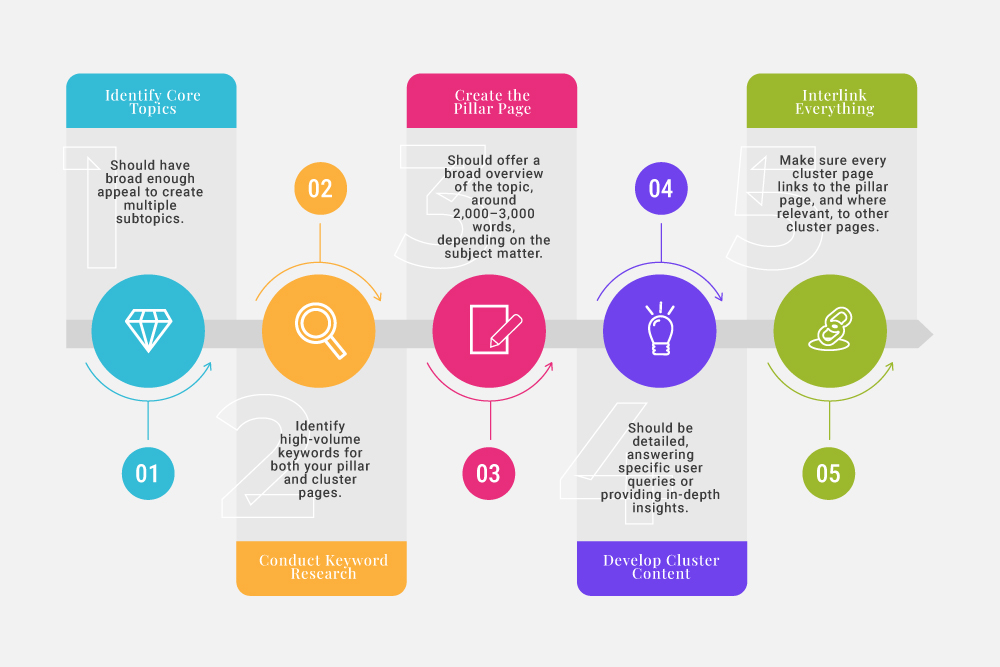Ranking high on search engines requires more than just individual keyword targeting. As Google and other search engines become increasingly sophisticated, they prioritize content that comprehensively addresses a topic rather than scattered keyword attempts. This is where content clustering becomes a powerful tool for SEO.
What is Content Clustering?
Content clustering is a strategic SEO method where you group related content around a central theme or “pillar” page. The pillar page broadly covers the core topic, while individual “cluster” pages delve deeper into specific subtopics, all interlinked. This structure signals to search engines that your site is authoritative on the topic, improving visibility for both the pillar and its related cluster pages.
Why Content Clustering is Essential for SEO
- Improved Search Engine Crawling
Content clustering helps search engines like Google understand your website’s structure better. By linking related pieces of content, you create a hierarchy, making it easier for search engines to crawl and index your pages. When search engines see comprehensive coverage of a topic, they’re more likely to rank your pages higher in the search results.
- Increased Topical Authority
With content clustering, you’re not just publishing random pieces of content around a keyword; you’re building a holistic narrative around a topic. This boosts your site’s topical relevance, increasing the chances of ranking higher in search results. When Google sees interconnected, high-quality content around a topic, it views your website as an authority in that niche.
- Enhanced User Experience
Content clusters guide users through relevant information logically and efficiently. Instead of bouncing off your site after reading a single post, users are more likely to engage with multiple pages, reducing bounce rates and increasing dwell time, key metrics that impact SEO.
Building an Effective Content Cluster Strategy
To implement content clustering, follow these steps:

1. Identify Core Topics
Start by selecting core topics relevant to your industry that your audience is interested in. These topics should have broad enough appeal to create multiple subtopics. For example, if you’re in digital marketing, “SEO” could be a pillar topic, while cluster pages could cover “technical SEO,” “on-page SEO,” “link building,” and “local SEO.”
2. Conduct Keyword Research
Use SEO tools like SEMrush, Ahrefs, or Google Keyword Planner to identify high-volume keywords for both your pillar and cluster pages. Your pillar page should target a broad, high-competition keyword, while cluster pages focus on long-tail, niche keywords that delve into specific subtopics.
3. Create the Pillar Page
The pillar page should offer a broad overview of the topic, around 2,000–3,000 words, depending on the subject matter. It should include internal links to all the cluster pages. The content should be rich and informative, offering users comprehensive insights.
4. Develop Cluster Content
Each cluster page should target a specific subtopic and link back to the pillar page. These pieces should be detailed, answering specific user queries or providing in-depth insights. Include internal links to other related cluster pages to create a web of interconnected content.
5. Interlink Everything
The power of content clustering lies in interlinking. Make sure every cluster page links to the pillar page, and where relevant, to other cluster pages. This helps with both SEO and user navigation.
Real-World Example of Content Clustering
Let’s say you run a fitness blog. Your pillar page could be titled “Complete Guide to Fitness,” which covers broad fitness concepts. Cluster pages could include “Strength Training for Beginners,” “Best Cardio Workouts,” “Nutrition for Muscle Growth,” and “Rest and Recovery Tips.” Each cluster page would link back to the pillar page, and possibly to each other when relevant.
Benefits of Content Clustering for SEO
- Increased Organic Traffic: Since you’re targeting both broad and specific keywords, your chances of ranking for various search queries increase.
- Improved Rankings for Competitive Keywords: Your pillar page can help you rank for more competitive terms, while the cluster pages pull in traffic from long-tail keywords.
- Better User Engagement: By organizing content into related clusters, you guide users to explore more of your website, increasing engagement and potentially leading to higher conversions.
Final Thoughts
Content clustering is no longer optional if you’re serious about growing your organic search visibility. It aligns with the way search engines interpret content, providing both search engines and users with a clear and comprehensive structure. By building out clusters around core topics, you can boost your site’s authority, increase user engagement, and ultimately rank higher on search engine results pages (SERPs).





